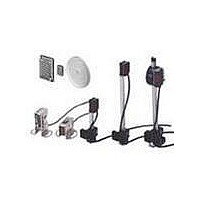E39-L59 Omron, E39-L59 Datasheet - Page 23

E39-L59
Manufacturer Part Number
E39-L59
Description
Industrial Photoelectric Sensors VERT MTG BRACKT E3S
Manufacturer
Omron
Type
General Purpose Photoelectric Sensorr
Specifications of E39-L59
Features
Control the laser with an Amplifier the same size as a Digital Fiber Amplifier
Light Source
Infrared LED
Connection
Prewired Cable
Output Configuration
NPN
Accessory Type
Mounting Bracket(s)
For Use With
E3S-A Sensors
Lead Free Status / RoHS Status
Lead free / RoHS Compliant
For Use With/related Products
Vertical E3S-A Series
Lead Free Status / RoHS Status
Lead free / RoHS Compliant, Lead free / RoHS Compliant
Noise
Countermeasures for noise depend on the path of noise entry, frequency components, and wave heights. Typical measures are as given in the
following table.
● Wiring
Cable
Unless otherwise indicated, the maximum length of cable extension is
100 m using wire that is 0.3 mm
Exceptions are indicated in Safety Precautions in individual product
information.
Cable Tensile Strength
When wiring the cable, do not subject the cable to a tension greater than
that indicated in the following table.
Note: Do not subject a shielded cable or coaxial cable to tension.
Repeated Bending
Normally, the Sensor cable should not be bent repeatedly.
(For bending-resistant cable, see
page C-4.)
Common mode noise
(inverter noise)
Radiant noise
Power line noise
Ingress of electromag-
applied between the
mounting board and
quency electromag-
netic waves directly
netic induction from
and switching noise
Ingress of high-fre-
lines, respectively.
high-voltage wires
from the switching
into Sensor, from
Type of noise
Common noise
the +V and 0-V
power line, etc.
power supply
Cable diameter
Less than 4 mm
4 mm or greater
http://www.ia.omron.com/
Noise enters from the noise source through the frame
(metal).
Noise propagates through the air from the noise source
and directly enters the Sensor.
Noise enters from the power line.
2
Mounting block
(metal)
or greater.
Attachment to Moving Parts
Noise
source
Sensor
Sensor
Before countermeasure
Tensile strength
30 N max.
50 N max.
Noise
Noise
Sensor
Photoelectric Sensors Technical Guide
+V
0V
Noise intrusion path and countermeasure
on
Inverter
motor
+V
0V
IM
Noise
+V
0V
Separation from High Voltage (Wiring Method)
Do not lay the cables for the Sensor together with high-voltage lines
or power lines. Placing them in the same conduit or duct may cause
damage or malfunction due to induction interference. As a general
rule, wire the Sensor in a separate system, use an independent metal
conduit, or use shielded cable.
Work Required for Unconnected Leads
Unused leads for self-diagnosis outputs or other special functions
should be cut and wrapped with insulating tape to prevent contact with
other terminals.
(c)Copyright OMRON Corporation 2008 All Rights Reserved.
(1) Ground the inverter motor (to 100 Ω or less)
(2) Ground the noise source and the power supply (0-V
(3) Insert an insulator (plastic, rubber, etc.) between the
• Insert a shield (copper) plate between the Sensor and
• Separate the noise source and the Sensor to a distance
• Insert a capacitor (e.g., a film capacitor), noise filter (e.g.,
the noise source e.g., a switching power supply).
where noise does not affect operation.
ferrite core or insulated transformer), or varistor in the
power line.
side) through a capacitor (film capacitor, 0.22 μF, 630
V).
Sensor and the mounting plate (metal).
Mounting block
(metal)
(3)
Insert an insulator.
Noise
source
Sensor
Sensor
After countermeasure
Power line
Insert a capacitor, etc.
(2)
Shield plate (copper)
Sensor
Noise
Noise
+V
0V
Inverter motor
Noise
IM
+V
0V
Noise
+V
0V
(1)
C-3









